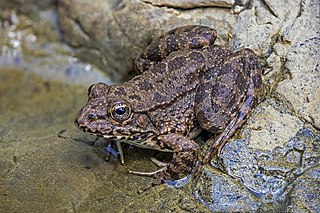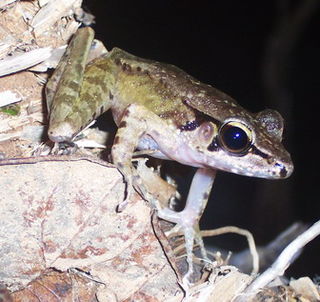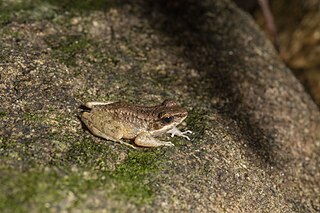Distribution and ecology
Hose's frog has been recorded from the Malay Peninsula south of the Kra Isthmus, on Phuket, Tioman, Borneo, the Batu Islands, Sumatra, Simeulue, [4] Bangka Island, Belitung and Java. It lives in and along clear, swift streams and rivers in rainforest up to 1,700 meters ASL. Though declining in recent times due to deforestation, it is still widely distributed and plentiful, and there is evidence that it is more tolerant of pollution and will morer readily accept secondary forest than many other frogs in the region. It is therefore listed as a Species of Least Concern by the IUCN. [1]
Eggs are probably deposited in water in a way roughly similar to other true frogs. But the eggs inside their gelatinous outer layer are cream-coloured without a dark hemisphere, indicating a specialised oviposition site.

True frogs is the common name for the frog family Ranidae. They have the widest distribution of any frog family. They are abundant throughout most of the world, occurring on all continents except Antarctica. The true frogs are present in North America, northern South America, Europe, Africa, and Asia. The Asian range extends across the East Indies to New Guinea and a single species, the Australian wood frog, has spread into the far north of Australia.

Amolops is a genus of true frogs native mainly to eastern and south-eastern Asia. These frogs are closely related to such genera as Huia, Meristogenys, Odorrana, Pelophylax and Rana, but still form a distinct lineage among the core radiation of true frogs. They are commonly known as "torrent frogs" after their favorite habitat - small rapid-flowing mountain and hill streams - but this name is used for many similar-looking frogs regardless of whether they are loosely related.

Huia is a group of true frogs found in Southeast Asia. Many are commonly known as "torrent frogs" after their favorite habitat - small rapid-flowing mountain and hill streams -, but this name is used for many similar-looking frogs regardless of whether they are closely related. A seemingly less ambiguous name is huia frogs; however, the supposed genus seems actually to be a polyphyletic "wastebin taxon" and might contain only a fraction of the dozens of species placed here by some authors.

Meristogenys is a genus of true frogs from Borneo. Its tadpoles are adapted to fast-flowing mountain streams and easily recognizable by their divided upper lip with ribs on the outside.
Odorrana tormota, also known as the concave-eared torrent frog, is a species of frog native to China. Its distribution is restricted to Huangshan Mountains in Anhui and Jiande and Anji counties in northern Zhejiang. It occurs in fast-flowing streams and the surrounding habitats, and breeds in streams. The informally assigned common name for frogs in this genus is torrent frog.
Amolops monticola is a species of frog in the family Ranidae, the "true frogs". It is found in the Northeast India, eastern Nepal, and western China, although there is some uncertainty regarding the Chinese records. It probably also occurs in the intervening Bhutan. Common names mountain sucker frog, mountain stream frog, mountain torrent frog, and mountain cascade frog have been coined for it.

Amolops cremnobatus is a species of frogs in the family Ranidae. It is found in north-central Laos and Vietnam. Its range might extend into Thailand. The specific name cremnobatus is derived from Greek kremnobates, meaning "frequenter of steep places", and refers to the steep waterfall from which the type series were collected. Common name Lao sucker frog has been coined for it.
Amolops tuberodepressus is a species of frog in the family Ranidae. It is endemic to Yunnan, China and known from Wuliang and Ailao Mountains in Jingdong County. Once suspected to be synonym of Amolops mantzorum, its validity was confirmed with molecular methods in 2014.
Meristogenys amoropalamus is a species of frog in the family Ranidae. It is endemic to northern Borneo and occurs in northwestern Sabah and northeastern Sarawak (Malaysia) and in northeastern Kalimantan (Indonesia). Common names mountain Borneo frog and mountain torrent frog have been coined for it. Studies of its larvae revealed that the nominal species contained two cryptic forms, and in 2011, Shimada and colleagues described Meristogenys dyscritus as a separate species.
Meristogenys macrophthalmus is a species of frog in the family Ranidae. It is endemic to Sarawak in northern Borneo (Malaysia) and is only known from its type locality in the Bintulu District. The specific name macrophthalmus is derived from the Greek words macros (="large") and ophthalmos (="eye") and refers to the large eyes of this frog. Common names Matsui's Borneo frog, large-eyed torrent frog, and big-eyed torrent frog have been coined for it.
Meristogenys poecilus is a species of frog in the family Ranidae. It is endemic to Borneo and known from between central Sarawak (Malaysia) and central Kalimantan (Indonesia). The specific name poecilus is derived from the Greek poikolos, meaning "pied" or "blotched", in reference to diagnostic pattern on rear of the thigh. Common name Malaysian Borneo frog has been coined for this species.
Meristogenys whiteheadi is a species of frog in the family Ranidae. It is endemic to Borneo and found in both Indonesia (Kalimantan) and Malaysia. Meristogenys stigmachilus and Meristogenys stenocephalus, described as new species in 2011, were formerly included in this species. Owing to the difficulty of distinguishing these species under field conditions, the exact range of this species is uncertain. Its common name is Whitehead's Borneo frog or Whitehead's torrent frog.

The Amami tip-nosed frog is a species of frog in the family Ranidae. It is endemic to the Amami Islands, a part of the Ryukyu Islands, Japan. Specifically, it is known from the islands of Amamioshima and Tokunoshima.
Amolops daorum is a species of frog in the family Ranidae. It is known from its type locality in the vicinity of Sa Pa in northern Vietnam near the Chinese border, Hong Kong, and Houaphanh Province in eastern Laos; presumably it also occurs the intervening areas. The Hong Kong record is considered suspicious, however.
Odorrana junlianensis, also known as the Junlian odorous frog, is a species of frogs in the family Ranidae. It is found in southern China and in the northernmost Laos and Vietnam. Its type locality is the eponymous Junlian County in Sichuan.
Odorrana supranarina is a species of frog in the family Ranidae. It is endemic to Ryukyu Archipelago, Japan, and is known from the islands of Ishigaki and Iriomote, both in the Yaeyama Group. The specific name supranarina refers to the large size of this species —at the time of the species description, it was the largest member of the so-called Rana narina complex. Common name greater tip-nosed frog has been coined for it.

Odorrana utsunomiyaorum is a species of frog in the family Ranidae. It is endemic to Ryukyu Archipelago, Japan, and is known from the islands of Ishigaki and Iriomote, both in the Yaeyama Group. The specific name utsunomiyaorum honours Taeko and Yasuaki Utsunomiya for their contributions to clarifying the amphibian fauna of the Yaeyama Group.

Odorrana is a genus of true frogs (Ranidae) from East Asia and surrounding regions. Many of these frogs inhabit fast-flowing mountain streams, and they typically have a remarkably pointed snout, as evidenced by common names like tip-nosed frog and scientific names like nasica or nasutus.

Pelophylax is a genus of true frogs widespread in Eurasia, with a few species ranging into northern Africa. This genus was erected by Leopold Fitzinger in 1843 to accommodate the green frogs of the Old World, which he considered distinct from the brown pond frogs of Carl Linnaeus' genus Rana.
Chalcorana rufipes is a species of "true frog" in the family Ranidae. It is endemic to Sumatra, Indonesia. It was split off from Chalcorana chalconota by Robert Inger and colleagues in 2009, along with a number of other species. The specific name rufipes is derived from Latin rufus meaning reddish and pes meaning foot, in reference to the reddish tinge on the underside of the pedal webbing in life.










